STRIP BAITS FOR TROLLING
1 Introduction
There are several kinds of strip baits you can make cut from the belly section of a Dolphin, small Tuna or mullet. These are extremely tough, an excellent choice for fishing teasers. Strip baits are cut from the belly section of small Tuna or Dolphin.
2 Catch your bait
Always use fresh bait as it is by far the best or good brined baits. Tuna deteriorates very quickly if not brined or in warm conditions. Use small bonito feathers on the way out to the sailfish grounds in order to catch small tuna and school dolphin. Use very small lures and light leaders for maximum success.
3 Brine and ice your bait
Brine the baits in order to make the flesh more firm and fresh. Cut the tuna after you put the bait in the brine and on ice for about one hour. You can also cut the belly section and salt it and lay it on ice, I prefer to brine the whole fish on ice and then cut it after it's chilled.
4 Cutting the belly section after brining
NOTE - Knives must be very sharp. The edges of the strip baits have to be cut very cleanly.
[size=-1]
 [/size]
[/size]
Cut the tuna in front of the anal fin and finish off just behind the pectoral fins. Some prefer to begin the cut just behind the anal fin and carry on all the way to the throat latch. This gives several advantages. The throat latch meat is extremely tough and strong. The pectoral fins also act to stabilize the bait.
I prefer to stitch the pectoral fins so they stick out like the wings of a flying fish. I don't recommend this unless you are very skilled in trolling hookless teasers. The stuck-out fins make it hard for a fish to swallow the bait unless you know what you doing. Finally cut out the anal fin once the belly is cut out, creating a forked tail which flaps and wiggles.
5 Rigging your Hooks and leaders
For strip baits, simply crimp a length of cable or mono leader to the hook and finish the other end as normal. Cable is better when there are lots of toothy critters about. For shy sailfish, drop down to 40 pound fluro in order to get strikes. Again here if you are skilled and experienced otherwise 60 or 80 lb. Hooks for strip bait rigs need to be fairly large to clear the bait when it's stitched. I like a 7/0 to 8/0 O' (Mustad 34007) because it's easy to sharpen and penetrate on light tackle. If you are preparing the bait for King mackerel or other toothy fish, use chain gang hooks. The smaller the strips are so use a smaller hook. A 5/0 or 6/0 Mustad. I use circle hooks for better hook up ratio.
6 Stitching your strip bait[font="New York, Times New Roman"][size=-1]

[/size][/font]
Strip baits are stitched together edge to edge. The best stitching string is Dacron. Dont use cotton rather use waxed dental floss as an alternate. Pull out an adequate length of string and pass the needle through the cartilage right at the front of the bait above the pectoral fins. This is the strongest part of the bait.
Pass the needle through the leader loop. Repeat, the loop, not the eye of the hook. Pass the needle out the other side of the bait. Stitches should go across the bait and enter the bait from the other side. Some people stitch the bait all the way down to the tail. I prefer to stitch until where the hook comes out of the bait, leaving a forked tail for more wiggle. Stitch back up. The stitches must close the bait firmly and be deep enough so that they cannot easily be torn out. The stitch pattern along the top of the bait should look like a row of Xs.
Note 1: Do not drive the hook through the belly of the bait. The hook should lay on top of the bait with the hook facing the other way. When the bait is stitched, the hook point rides up. This procedure sounds intimidating but it's easy in practice. After you have done a few you should get the hang of it.
Note 2: The best needles to use for all bait rigging are the Stainless steel type with three cutting edges, known as Morticians needles.
7 Striking procedure
If the strip baits are rigged with chian gang hooks, set the reel in strike drag and try and hook them up instantly. For sailfish, using Fluro leaders with single circle hooks, set the reel drag on the clicker only or very very light. Let the fish take out line until it's turned and running quickly, then push the reel to strike and reel until line is coming off under drag tension, then reel in and come tight.

8 Skirts on your baits
These can be quite useful for tracking the baits more easily. You can also pull a strip bait faster with the squid skirt. Bright colours like pink, fluoro green and orange are excellent. Sailfish and dorado like pink skirts best. Choose a skirt big enough to accomodate the head of the bait. Sometimes, a skirt with an egg sinker stuffed into the head is useful for making the strip bait run below the surface. Good for bigblue marlin, but I like a surface-running bait for Sailfish, striped marlin, tuna and wahoo.
10 Use fresh baits regularly
Change your baits regularly. You baits can last for about hours before losing flavour, alos depends on sea conditions and trolling speed. I prefer to replace them every hour as it gives you an opportunity to see how the baits are running or if anyhing is foul hooked or dragging on the hooks. Sailfish in particular respond much better to good, fresh baits.
Another neat thing about strip baits is that they can be fished anywhere in the spread. They will skip and splash on the surface when fished straight off the flat lines, and they’re ’rigger-friendly, too. In fact, when a fish eats one from a ’rigger, a drop back is rarely required, as the bait’s small size, coupled with the slack line, virtually ensures a solid hook-up. Furthermore, the scent and taste of a fresh strip bait often fools a fish into holding onto it longer or coming back for another strike.
Here is another quick method also :
Preparing the Strip
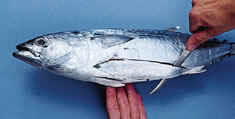 Step 1 Carve out a section from the belly of a bonito, tuna, king mackerel or dolphin.
Step 1 Carve out a section from the belly of a bonito, tuna, king mackerel or dolphin.
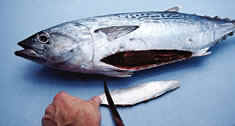 Step 2 Trim the belly section. For best results, blunt the head and taper the tail. Note: The grain of the meat should flow toward the tail of the strip to keep it from balling up and washing out.
Step 2 Trim the belly section. For best results, blunt the head and taper the tail. Note: The grain of the meat should flow toward the tail of the strip to keep it from balling up and washing out.
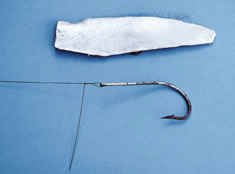
Step 3 Take a long shank, needle-eye hook and secure it to eight to ten feet of stainless-steel, single-strand leader wire with a haywire twist/barrel wrap. Leave an extended tag (pin) that’s pointed down toward the hook point. For 20- and 30-pound tackle, I prefer a size 8/0 hook and No. 7 (80-pound test) leader wire, whereas I’ll opt for a 9/0 hook and No. 8 (93-pound test) leader wire for 50-pound tackle. Form a loop at the leader’s opposite end, to join the snap swivel on the fishing line.
Rigging the Strip
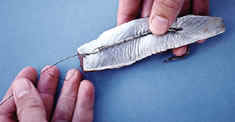 Step 1 Measure where the hook will ride by laying it on the strip. Be sure to account for the tag-end pin, which will be used to secure the head of the strip. Once you have determined where the hook will ride, use a knife to make a small incision in the skin to help facilitate insertion of the hook. Now, run the hook point through the skin of the bait, then push through the tag end of the leader. Next, bend the tag end approximately 80 to 90 degrees.
Step 1 Measure where the hook will ride by laying it on the strip. Be sure to account for the tag-end pin, which will be used to secure the head of the strip. Once you have determined where the hook will ride, use a knife to make a small incision in the skin to help facilitate insertion of the hook. Now, run the hook point through the skin of the bait, then push through the tag end of the leader. Next, bend the tag end approximately 80 to 90 degrees.
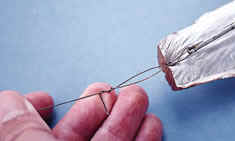
Step 2 Secure the tag end of the leader to the standing section by taking two wraps and folding the tag toward the bait. The tag end should be easy to unwind so you can change strips.

Step 2 (optional) For visual appeal, and to increase the strip’s longevity, add a trolling skirt or lure
Rigging strip baits with Cable ties is a quick and easy method as well.
Mostly used when using a fillet of a large fish when game fishing, this method is extremely effective. The bait hangs well and will not bunch over the hooks bight and larger hooks are usable without damage to the bait.
The choice of passing the point of the hook through the bait is optional, however, on most instances not necessary









